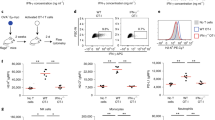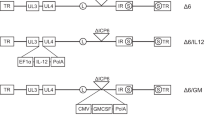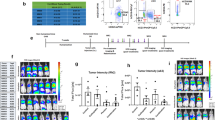Abstract
The Flt3 ligand (Flt3-L) manifests antitumor activity, presumably due to its capacity to recruit dendritic cells and cause their proliferation. To assess whether local production of Flt3-L can mediate a “distant bystander” effect, murine B4B8 squamous cell carcinoma cells were transfected with a plasmid encoding a secretory form of Flt3-L to produce B4B8FL cells. Similarly, B4B8FL and B4B8 cells were transfected with herpes simplex virus thymidine kinase (HSVTK) to produce B4B8TK and B4B8FL/TK cells, which should be sensitive to ganciclovir (GCV), to know whether the effects of Flt3-L and HSVTK/GCV would be synergistic. To test for a distant bystander effect in vivo, B4B8FL, B4B8TK, and B4B8FL/TK cells were injected subcutaneously into the left flank of syngeneic Balb/c mice, and naïve B4B8 cells were injected into the right flank. The formation of tumors derived from B4B8FL and B4B8FL/TK cells was significantly delayed in both flanks compared with naïve B4B8 and B4B8TK cells. Growth of B4B8TK tumors in the ipsilateral flank was retarded following GCV treatment, but in contrast to B4B8FL and B4B8FL/TK cells, no distant bystander effect in the contralateral flank was observed. Immunohistochemistry showed lymphocytic infiltrates in both flanks of the B4B8FL and B4B8FL/TK groups. The data indicate that in these cells, local secretion of Flt3-L is sufficient to evoke a distant bystander effect but that expression of HSVTK, even after GCV administration, is not. Furthermore, the combination of local Flt3-L and HSVTK production, together with GCV administration, does not enhance the distant bystander effect produced by Flt3-L alone.
This is a preview of subscription content, access via your institution
Access options
Subscribe to this journal
Receive 12 print issues and online access
$259.00 per year
only $21.58 per issue
Buy this article
- Purchase on Springer Link
- Instant access to full article PDF
Prices may be subject to local taxes which are calculated during checkout








Similar content being viewed by others
References
Fearon E, Pardoll D, Itaya T, et al. Interleukin-2 production by tumor cells bypasses T helper function in the generation of an anti-tumor response. Cell. 1990;60:397–403.
Armstrong CA, Botella R, Galloway TH, et al. Anti-tumor effects of granulocyte–macrophage colony-stimulating factor production by melanoma cells. Cancer Res. 1996;56:2191–2198.
Chen SH, Chen XHL, Wang Y, et al. Combination gene therapy for liver metastasis of colon carcinoma in vivo. Proc Natl Acad Sci. 1995;92:2577–2581.
Seong JY, Dae SH, Jung OK, et al. Synergistic anti-tumor effects with co-expression of GM-CSF and IFN-r in murine tumors. Int J Cancer. 1998;77:907–912.
Goolee S, Heo DS, Yoon SJ, et al. Effect of GM-CSF and IL-2 coexpression on the anti-tumor immune response. Anticancer Res. 2000;20:2681–2686.
Felzmann T, Ramsey WJ, Blaese RM . Characterization of the anti-tumor immune response generated by treatment of murine tumor with recombinant adenoviruses expressing HSVtk, IL-2, IL-6 or B7-1. Gene Ther. 1997;4:1322–1329.
Allione A, Consalvo M, Nanni P, et al. Immunizing and curative potential of replicating and nonreplicating murine mammary adenocarcinoma cells engineered with interleukin IL-2, IL-4, IL-6, IL-7, IL-10, tumor necrosis factor alpha, granulocyte–macrophage colony-stimulating factor, and gamma interferon gene or admixed with conventional adjuvants. Cancer Res. 1994;54:6022–6026.
Cheng YC, Grill SP, Dutschman GE, et al. Metabolism of 9-(1,3-dihydroxy-2-2 propoxymethyl) guanine, a new anti-herpes virus compound in herpes simplex virus–infected cells. J Biol Chem. 1983;258:12460–12464.
Bi WL, Parysek LM, Warnick R, et al. In vitro evidence that metabolic cooperation is responsible for the bystander effect observed with HSVtk retroviral gene therapy. Hum Gene Ther. 1993;4:725–731.
Freeman SM, Abboud CN, Whartenby KA, et al. The “bystander effect”: tumor regression when a fraction of the tumor mass is genetically modified. Cancer Res. 1993;53:5274–5283.
Elshami AA, Saavedra A, Zhang H, et al. Gap junctions play a role in the “bystander effect” of the herpes simplex virus thymidine kinase/ganciclovir system in vitro. Gene Ther. 1996;3:85–92.
Wygoda MR, Wilson MR, Davis MA, et al. Protection of herpes simplex virus thymidine kinase–transduced cells from ganciclovir-mediated cytotoxicity by bystander cells: the Good Samaritan effect. Cancer Res. 1977;57:1699–1703.
Kim YG, Bi WL, Feliciano ES, et al. Ganciclovir-mediated cell killing and bystander effect is enhanced in cells with two copies of the herpes simplex virus thymidine kinase gene. Cancer Gene Ther. 2000;7:240–246.
Lyman SD, James L, Johnson L, et al. Cloning of the human homologue of the murine flt3 ligand: a growth factor for early hematopoietic progenitor cells. Blood. 1994;83:2795–2801.
Hannum C, Culpepper J, Campbell D, et al. Ligand for flt4/flk2 receptor regulates growth of haematopoietic stem cells and is encoded by variant RNAs. Nature. 1994;368:643–648.
Lyman SD, Brasel K, Escobar SS, et al. Identification of a soluble and membrane bound isoforms of the murine flt3 ligand generated by alternative splicing of mRNAs. Oncogene. 1995;10:149–159.
Maraskovsky E, Brasel K, Teepe M, et al. Dramatic increase in the numbers of functionally mature dendritic cells in Flt3 ligand-treated mice: multiple dendritic cell subpopulations identified. J Exp Med. 1996;184:1953–1962.
Steptoe RJ, Fu F, Li W, et al. Augmentation of dendritic cells in murine organ donors by Flt3 ligand alters the balance between transplant tolerance and immunity. J Immun. 1997;159:5438–5491.
Chen K, Braun S, Lyman S, et al. Anti-tumor activity and immunotherapeutic properties of Flt3-ligand in a murine breast cancer model. Cancer Res. 1997;57:3511–3516.
Lynch DH, Andreasen A, Maraskovsky C, et al. Flt3 ligand induces tumor regression and anti-tumor immune response in vivo. Nat Med. 1997;3:625–631.
Esche C, Subbotin VM, Maliszewski C, et al. Flt3-ligand administration inhibit tumor regression growth in murine melanoma and lymphoma. Cancer Res. 1998;58:380–383.
American Cancer Society. Facts and Figures. Washington, DC: American Cancer Society; 2000.
Landis SH, Murray T, Bolden S, et al. Cancer statistics. Cancer J Clin. 1998;1:6–29.
Day KV, Li D, Liu S, et al. Granulocyte–macrophage colony-stimulating factor in a combination gene therapy strategy for head and neck cancer. Laryngoscope. 2001;111:801–806.
O'Malley BW, Chen SH, Schwartz MR, et al. Adenovirus-mediated gene therapy for human head and neck squamous cell cancer in a nude mouse model. Cancer Res. 1995;55:1080–1085.
Bi WL, Kim YG, Feliciano ES, et al. An HSVtk-mediated local and distant anti-tumor bystander effect in tumors of head and neck origin in athymic mice. Cancer Gene Ther. 1997;4:246–252.
Culver KW, Ram Z, Wallbridge S, et al. In vivo gene transfer with retroviral vector–producer cells for treatment of experimental brain tumors. Science (Washington, DC). 1992;256:1550–1552.
Ram Z, Culver KW, Walbridge S, et al. In situ retroviral-mediated gene transfer of the herpes simplex virus thymidine kinase gene and ganciclovir administration. Gene Ther. 1993;53:83–88.
Kianmanesh AR, Perrin H, Panis Y, et al. A “Distant” bystander effect of suicide gene therapy regression of nontransduced tumor together with a distance transduced tumor. Hum Gene Ther. 1997;8:1807–1814.
Agard C, Ligeza C, Dupas B, et al. Immune-dependent distant bystander effect after adenovirus-mediated suicide gene transfer in a rat model of liver colorectal metastasis. Cancer Gene Ther. 2001;8:128–136.
Wilson KM, Stambrook PJ, Bi WL, et al. HSV-tk gene therapy in head and neck squamous cell carcinoma. Arch Otolaryngol Head Neck Surg. 1996;122:746–749.
Lyman SD, Brasel K, Rousseau AM, et al. The flt3 ligand: a hematopoietic stem cell factor whose activities are distinct from steel factor. Stem Cells. 1994;12:99–107.
Small D, Levenseein M, Kim E, et al. The human homolog of flt2.flt3, is selectively expressed in CD34 human bone marrow cells and is involved in proliferation of early progenitory stem cells. Proc Natl Acad Sci. 1994;91:459–463.
Rosenet O, Schiff C, Pebusque MJ, et al. Human filt3/flt2 gene: cDNA cloning and expression in hematopoietic cells. Blood. 1993;82:1110–1119.
Qiao J, Blacb ME, Caruso M . Enhanced ganciclovir killing and bystander effect of human tumor cells transduced with a retroviral vector carrying a herpes simplex virus thymidine kinase gene mutant. Hum Gene Ther. 2000;11:1569–1576.
Chen CY, Chang YN, Ryan P, et al. Effect of herpes simplex virus thymidine kinase expression levels on ganciclovir-mediated cytotoxicity and the “bystander effect”. Hum Gene Ther. 1995;6:1467–1476.
Chen SH, Kosai K, Xu B, et al. Combination suicide and cytokine gene therapy for hepatic metastases of colon carcinoma: sustained anti-tumor immunity prolongs animal survival. Cancer Res. 1996;15:3758–3762.
Freund CT, Sutton MA, Dong T, et al. Adenovirus-mediated combination suicide and cytokine gene therapy for bladder cancer. Anticancer Res. 2000;20:1359–1365.
Toda M, Martuza RI, Rabkin SD . Combination suicide/cytokine gene therapy as adjuvants to a defective herpes simplex virus–based cancer vaccine. Gene Ther. 2001;8:332–339.
Mesnil M, Yamasaki H . Bystander effect in herpes simplex virus-thymidine kinase/ganciclovir cancer gene therapy: role of gap-junctional intercellular communication. Cancer Res. 2000;60:3989–3999.
Wei MX, Bougnoux P, Sacre-salem B, et al. Suicide gene therapy of chemically induce mammary tumor in rat: efficacy and distant bystander effect. Cancer Res. 1998;58:3529–3532.
Engelmann C, Heslan JM, Fabre M, et al. Importance mechanisms and limitations of the distant bystander effect in cancer gene therapy of experimental liver tumors. Cancer Lett. 2002;179:59–69.
Suan J, Michael A . The clinical problem and immuno-modulation. In: Habib NA, ed Cancer Gene Therapy: Past Achievements and Future Challenges. 1st ed. New York: Kluwer Academic Publishing/Plenum; 1999:292–293.
Liau LM, Black KL, Prins RM, et al. Treatment of intracranial gliomas with bone marrow–derived dendritic cells pulsed with tumor antigens. J Neurosurg. 1999;90:1115–1124.
Nouri-Shirazi M, Banchereau J, Bell D, et al. Dendritic cells capture killed tumor cells and present their antigens to elicit tumor-specific immune responses. J Immunol. 2000;165:3797–3803.
Braun SE, Chen K, Balzar BR, et al. Flt3 ligand antitumor activity in a murine breast cancer model: a comparison with granulocyte–macrophage colony-stimulating factor and a potential mechanism of action. Hum Gene Ther. 1999;10:2141–2151.
Von Eckardstein KL, Patt S, Zhu J, et al. Short-term neuropathological aspects of in vivo suicide gene transfer to the F98 rat glioblastoma using liposomal and viral vectors. Histol Histopathol. 2001;16:735–744.
Author information
Authors and Affiliations
Corresponding author
Rights and permissions
About this article
Cite this article
Dong, J., Bohinski, R., Li, YQ. et al. Antitumor effect of secreted Flt3-ligand can act at distant tumor sites in a murine model of head and neck cancer. Cancer Gene Ther 10, 96–104 (2003). https://doi.org/10.1038/sj.cgt.7700534
Received:
Published:
Issue Date:
DOI: https://doi.org/10.1038/sj.cgt.7700534
Keywords
This article is cited by
-
Effect of Flt3 ligand gene transfer in experimental pancreatic cancer
International Journal of Colorectal Disease (2006)
-
Murine mammary adenocarcinoma cells transfected with p53 and/or Flt3L induce antitumor immune responses
Cancer Gene Therapy (2005)



